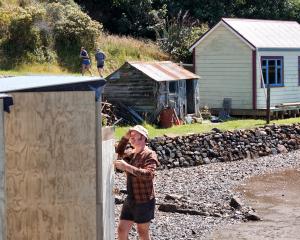Hundreds of motorists pass it daily but few probably know the origins of a small, simple building on the west side of the main road near Milton.
Little indicates that it is a former tollhouse, built to house a tollkeeper who collected fees from travellers as they passed through his gate.
Built about 1863 by the Otago Provincial Government, it was originally located at Waihola Gorge (Lower Taieri Ferry), a main route between Dunedin and Central Otago.
In 1876, it was moved to nearby Clarendon, where it also served as the railway station and post office.
Restored by a trust and recently registered as a category 1 historic place, it is thought to be the only remaining toll house in the South Island.
According to the New Zealand Historic Places Trust, it is also a reminder of the importance of roading in the pioneering days of European settlement.
Today, New Zealand has only one state highway toll road, north of Auckland, but in the 19th century, money from a network of toll houses was crucial in developing the all-weather roads that provided access to ports and enabled inland areas to be settled.
Inherited from Britain, the toll system was at times controversial, a Historic Places Trust report on the Clarendon toll house says.
One New Zealand politician described tolls as "one of the most obnoxious systems of taxation" while another settler pointed out that in Britain, the system was "increasingly archaic" once railways were established as an alternative.
In Kaiwharawhara, near Wellington, citizens ripped out the toll gates, burnt them and threw the remains in the harbour. Teamsters also tried to evade the highest charges by unhooking some of their horses as they approached the toll gates and leading them behind their wagons.
As well as funding road construction, charging tolls could be a political statement. The Kingitanga authorities erected a toll gate at the entrance to their land and charged all who passed it, while others tried to use tolls to discourage travel on the Sabbath.
The first toll houses in Otago were proposed in 1863 for the Dunedin town belt, the Water of Leith and various places on the Taieri.
By 1868, there were 13 toll gates, some of which were moved between locations as needed.
The charges were complex and depended on factors such as the kind of wheeled vehicle, the number of animals drawing it and the job of the individual traveller.
There was also a list of exemptions.
These included those carting materials for road repairs, animals on the way to work the land, those going to church, police and their prisoners, mail carriers, soldiers conveying arms and judges on the way to perform their duty.
Fines were imposed on those who tried to avoid the toll by going around the gates and landowners who knowingly allowed someone to cross their land to evade the charges. It was also an offence to engineer it so that when passing a toll, there were fewer horses hitched to a vehicle.
The leases of the toll houses were auctioned, with leaseholders paying for the right to collect the tolls which formed their income.
However, tollkeepers were far from popular and often had to take evaders to court to recover their money.
In 1866, Otago carriers took strike action over the toll charged on horse-drawn wagons.
The three-week strike saw 500 horses idle and their owners and families without income.
Toll houses were used not just for revenue collection but as polling places in elections, meeting rooms, and somewhere important papers such as tender documents could be viewed.
They largely disappeared in the early 1920s and since then tolls have been used only occasionally - at Auckland Harbour Bridge, Tauranga Harbour Bridge and the Lyttelton road tunnel.












